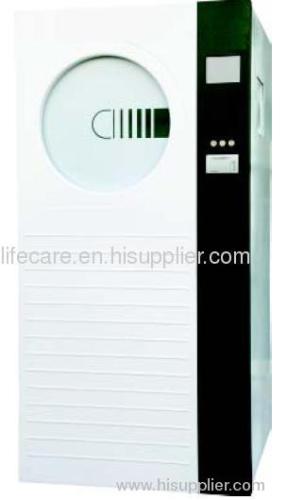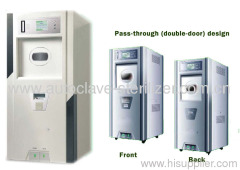
|
Yongfeng Enterprise Co., Ltd.
|
Hydrogen peroxide Sterilizers
| Payment Terms: | T/T,WU |
| Place of Origin: | Zhejiang, China (Mainland) |
|
|
|
| Add to My Favorites | |
| HiSupplier Escrow |
Product Detail
Hydrogen peroxide Low Temperature Plasma Sterilizer, for metals and nonmetal apparatus, specially precise apparatus which fear hot & wet sterilization
Hydrogen peroxide Low Temperature Plasma Sterilizer
The main usage:
Plasma sterilizer is applicable to metals and nonmetal apparatus sterilized, it is specially applicable precise apparatus which fear hot & wet, It can be used for the operating room, CSSD and other treatment
room.
Plasma sterilizer is applicable to metals and nonmetal apparatus sterilized, it is specially applicable precise apparatus which fear hot & wet, It can be used for the operating room, CSSD and other treatment
room.
Applicative material:
Aluminum, copper, acetal resin, multipolymer, glass, ethylene-acetic acid ethylene, LCD multipolymer, polycarbonate, titanium, nylon, polyurethane, PVC, stainless steel, poly(etherether-ketone), teflon, polyether imide, polystyrene, polypropylene, poly(methylmethacrylate), silicone elastomer
Aluminum, copper, acetal resin, multipolymer, glass, ethylene-acetic acid ethylene, LCD multipolymer, polycarbonate, titanium, nylon, polyurethane, PVC, stainless steel, poly(etherether-ketone), teflon, polyether imide, polystyrene, polypropylene, poly(methylmethacrylate), silicone elastomer
Inapplicable material:
The stainless steel piping instruments which internal diameter less than 1mm, length more than 400mm
Moisture absorption material(wooden instruments, fibrin, cotton fabric, gauze etc.)
Disposable instruments (disposable fabric, disposable operating dress etc.)
Liquid or powder
The material with incomplete drying
The lumen one side closed
Normal implant
The instruments can't endure vacuum and can be sterilized only be steam
The stainless steel piping instruments which internal diameter less than 1mm, length more than 400mm
Moisture absorption material(wooden instruments, fibrin, cotton fabric, gauze etc.)
Disposable instruments (disposable fabric, disposable operating dress etc.)
Liquid or powder
The material with incomplete drying
The lumen one side closed
Normal implant
The instruments can't endure vacuum and can be sterilized only be steam
Dimension & weight:
Width: 820mm
Height: 1,670mm
Depth: 1,000mm
Weight: 450kg
Chamber:
Total capacity: 147 Litre
Available capacity: 100 Litre
Dimension: Depth 750mm Diameter 420mm
Width: 820mm
Height: 1,670mm
Depth: 1,000mm
Weight: 450kg
Chamber:
Total capacity: 147 Litre
Available capacity: 100 Litre
Dimension: Depth 750mm Diameter 420mm
Facilities:
Power: 220V, 50Hz, 13A
Environmental temperature: 10ºC-40ºC
The minimum installation space: 1200 x 1500mm
The minimum distance to back wall: 100mm
The minimum maintenance distance : 1meter for both sides
Power: 220V, 50Hz, 13A
Environmental temperature: 10ºC-40ºC
The minimum installation space: 1200 x 1500mm
The minimum distance to back wall: 100mm
The minimum maintenance distance : 1meter for both sides
Sterilization:
The whole sterilization cycle time short cycle: 45min
Long cycle: 60min
Sterilization temperature: 40ºC±5ºC
Agent 60% concentration H2O2
High frequency power: 500W

The low temperature plasma sterilizers work in a principle that plasma state generated by means of high frequency voltage under low temperature (less than 60℃) and low pressure (less than 100Pa). During the generation of plasma the large amount of accompanying ultraviolet destroy gene of microorganism by means of the photolysis of the ultraviolet photon to damage the molecule chemical bond of microorganism and result in volatile compound such as CO, CHx. Etched microorganism is killed in the course of chemical reaction between the active material in plasma and protein and nucleic acid of microorganism.
Hydrogen peroxide is used as the sterilization medium, ionized under a vacuum condition inside the sterilizer chamber into a decomposition reaction which acts on the cells of microorganism and does the killing.
Plasma sterilization is an ideal method with almost all the advantages of sterilization manners. A shorter time is needed compared with high pressure steam sterilization and dry-heating sterilization. A lower temperature compared with chemical sterilization of oxygen ethylidene. Plasma is widely used in sterilization for many kinds of materials and products, especially various active articles generated can disappear within seconds after power is cut-off, no need of ventilation, no harm to operators, safe and reliable.
The whole sterilization cycle time short cycle: 45min
Long cycle: 60min
Sterilization temperature: 40ºC±5ºC
Agent 60% concentration H2O2
High frequency power: 500W

- Working principle
The low temperature plasma sterilizers work in a principle that plasma state generated by means of high frequency voltage under low temperature (less than 60℃) and low pressure (less than 100Pa). During the generation of plasma the large amount of accompanying ultraviolet destroy gene of microorganism by means of the photolysis of the ultraviolet photon to damage the molecule chemical bond of microorganism and result in volatile compound such as CO, CHx. Etched microorganism is killed in the course of chemical reaction between the active material in plasma and protein and nucleic acid of microorganism.
Hydrogen peroxide is used as the sterilization medium, ionized under a vacuum condition inside the sterilizer chamber into a decomposition reaction which acts on the cells of microorganism and does the killing.
Plasma sterilization is an ideal method with almost all the advantages of sterilization manners. A shorter time is needed compared with high pressure steam sterilization and dry-heating sterilization. A lower temperature compared with chemical sterilization of oxygen ethylidene. Plasma is widely used in sterilization for many kinds of materials and products, especially various active articles generated can disappear within seconds after power is cut-off, no need of ventilation, no harm to operators, safe and reliable.
2. Main purpose
Widely used in surgeries, service departments and treatment rooms in medical service centers and hospitals for medical instruments sterilization, especially for those precise instruments unendurable to heat and humidity.
3. Main features
Safe and environment protection
No toxic residue, no need of drainage and ventilation, no harm to operators, no pollution to the environment.
Easy for installation and reliable in performance
Powered by popular 220V, four foot wheels for easy movement and installation, computer control and very simple in operation, cycle processes recorded by printer.
Low temperature and negative pressure
Comparative dry condition sterilization under a temperature of 40-45℃ no harm to the sterilized instruments and materials
Economic
Shorter period of sterilization, simple instrument cycle is completed within 40 minutes and complicated instrument cycle is completed within 50-70 minutes, the instruments can be used directly after sterilization no need of cooling or other processes.
Cost for each cycle is lower and efficiency of the sterilized instruments is improved, spoilage and standby of the precise instruments is decreased, thus the cost is dramatically reduced.
Cost for each cycle is lower and efficiency of the sterilized instruments is improved, spoilage and standby of the precise instruments is decreased, thus the cost is dramatically reduced.
Adaptable to a wide range
Low temperature sterilization is suitable to 95% instruments, especially advanced for those electronic instruments unendurable to heat and humidity such as endoscope, electron meters, battery, cable camera and etc.
Network administration
Original data can be recorded for tracing with large storage memory.
Remote diagnostic system is adopted for monitoring and trouble display so that serviceman can make analysis and do the trouble-shooting, offering a continuous performance of the equipment.
Remote diagnostic system is adopted for monitoring and trouble display so that serviceman can make analysis and do the trouble-shooting, offering a continuous performance of the equipment.
4. Technical specification
| External dimension and weight | |||||||||||||
| Width | Height | Depth | Weight | ||||||||||
| 860mm | 1700mm | 1000mm | 450Kg | ||||||||||
| Chamber | |||||||||||||
| Shape | Capacity | Effective volume | Size | ||||||||||
| Round | 147Kg | 100Kg | Φ420×750mm | ||||||||||
| Installation and preparation requirement | |||||||||||||
| Power source | Environment temperature | Back distance To the wall | Min service distance | ||||||||||
| 220V/50Hz/15A | 10 to 40℃ | 1200× 1500mm | 100mm | 1000mm from two sides | |||||||||
| Sterilization time and temperature | |||||||||||||
| Time | Temperature | Medium | High frequency power source | ||||||||||
| Short cycle 45 min Long cycle 60 min | 45-50℃ | Hydrogen peroxide of 60% concentration | 13.56MHz Max power 500W | ||||||||||
5. Typical instruments applicable with this sterilizer
Stereo orientation devices, oesophagus dilator, patien end connection cable, laryngoscope peering piece, puncture outfit jacket, cold treatment detector, surgery energy supplier or battery, fiber-optic cable, defibrillation plate electrode, skull pressure sensor cable, endoscope, laser head, fiber and accessories, ophthalmic lens, head of pigmentation devices, doppler, electric cautery, metal instrument, hard endoscope, radiotherapy device, ultrasonic detector, vidicon and its connector, prostate guillotine/ working part, single track soft endoscope, razor head.
6. Typical materials applicable with this sterilizer
Aluminium, copper, acetal resin, copolymer, glass, ethylene-vinyl acetate, liquid crystal copolymer, polycarbonate, titanium, nylon, polyurethane, PVC, stainless steel, PEEK (polyether ether ketone), polythene-polyphenylene, teflon, polyetherimide, polyphenylene sulfone, polystyrene, polypropylene, polymethacrylic acid, silicone elastomer.
7. Materials inapplicable with this sterilizer
--Hard antrum instrument: those with tube size of inner diameter less than 1mm and length more than 400mm
--hygroscopic materials (paper, cellulose, cotton fabric, gauze and etc)
--One-off instruments (waterproof fabric, operation cloths)
--Powder
--Wooden instruments
--Ordinary plastic
--Sponge, microscope protection sponge
--Silk
--hygroscopic materials (paper, cellulose, cotton fabric, gauze and etc)
--One-off instruments (waterproof fabric, operation cloths)
--Powder
--Wooden instruments
--Ordinary plastic
--Sponge, microscope protection sponge
--Silk
8. Auxiliary device
a.Biology incubator Temperature: 56-59℃, Cultivation time: 48 hours
b.Biology indicator: heat-addicted fat bacillus; Quantity: 2 to 5x106, red in colour originally; also red after a qualified sterilization, but a failed sterilization if in orange.
c.Chemical indicator: Showing whether sterilization medium is distributed uniformly.
d.Packing bags: (for sealing the materials to be sterilized, made in WIPRK, Damark); Material: the front layer is polypropylene, the back layer is transparent HDPE synthetical paper; Temperature inside package: 115-130℃; Size: Width 75mm, 100mm, 150mm, 200mm, 250mm, 300mm
e.Sterilization medium: Hydrogen peroxide (H2O2); Concentration: 60%;
Container capacity: 200ml/bottle; Store temperature: 2-25℃.
f.Nonvowen fabric: (for packing disk and something likely);
Size: 500mm x 500mm, 800mm x 800mm
g.Loading basket: (two equipped with each sterilizer)
Size: 740mm x 265mm x 280mm (LxWxH).
9. Sterilization stages:
| No | Stage | Operation time |
| 1 | Vacuuming I | 13 to 16 minutes |
| 2 | Pervasion I | 6 to 10 minutes |
| 3 | Vacuuming II | 6 to 8 minutes |
| 4 | Plasma I | 2 minutes |
| 5 | Pervasion II | 6 to 10 minutes |
| 6 | Vacuuming III | 6 to 8 minutes |
| 7 | Plasma II | 2 minutes |
| 8 | Chamber relief | 1 to 2 minutes |
10.Plasma sterilizer components list
No | Name | Type | Manufacturer | Remark |
| 1 | Main body | PS-01 | Our company | |
| 2 | Vacuum pump | RVP2021I | ALCATEL France | |
| 3 | Throttle | 253D | MKS USA | |
| 4 | PLC | FX2N-48MT | MITSUBISHI Japan | |
| CPU224XP6ES7 | SIEMENS Germany | |||
| 5 | Touch screen | GT32T1 | Panasonic Japan | |
| 6 | Sterilization program | PS-ME1 | Our company | |
| 7 | DSM | U disc | Made In China | |
| 8 | Mini-type printer | SPRT-DIII | Made In China | |
| 9 | Pressure transducer | 626A21TBE | MKS USA | |
| 10 | Pressure controller | PSE531-M5 | SMC Japan | |
| 11 | Sterile filter | KVIV002PV1 | Pall USA | |
| 12 | Radio frequency power source | SY 1000W | Micro-electronic research institute, China | |
| 13 | Pressure relief solenoid | 220V/ VX2260M | SMC, Japan | |
| 14 | Injection solenoid | 220V/ VX2210M | SMC, Japan | |
| 15 | Electric pushrod | LAP25-N1 | LIM-TEC USA |
Didn't find what you're looking for?
Post Buying Lead or contact
HiSupplier Customer Service Center
for help!
Related Search
Hydrogen Generator
Hydrogen Gas Generator
Ammonium Hydrogen Fluoride
Nickel Hydrogen Battery
Nickel-Hydrogen Battery
More>>




.jpg)
.jpg)

